CitroŽn XM a
glorious failure?
|
|
|
The XM
represented a major failure for PSA. The
reasons for this are many and some of them are
less than clear. Hopefully this article will
go some way towards offering some
explanations. Before doing so, it is necessary
to place the XM within an historic
perspective.
In the beginning
Initially, CitroŽn
pitched his products at the bottom end of
the market - above the cyclecars that
provided basic, mass market transportation
but well below the luxury Gran Turismos
offered by the likes of Delahaye, Bugatti, Panhard, Hispano
Suiza, Bentley, Rolls Royce et al. In the
aftermath of World War One, motor car
manufacture was a labour intensive,
artisanal affair and the products were
expensive. Although there were large numbers
of manufacturers, thanks to fiscal tariffs,
it was not economic to sell one's products
abroad.
Andrť CitroŽn was a
great admirer of Henry Ford and sought to
emulate his success in Europe by employing
mass production techniques. This enabled him
to offer more car for the money and charge
less money for the car. However, unlike Ford
which offered but one model with but one
colour (any colour you like as long as it is
black), CitroŽn offered a range of cars with
a multitude of different body styles (and a
bewildering range of colours!). This
philosophy stood CitroŽn in good stead as
his firm produced a range of dull but worthy
cars at prices few of his competitors could
match.
|
|
C6 Ė the original
haut de gamme
Ever ambitious and ever
willing to exploit a niche, CitroŽn saw the
need for a competitively priced, high
performance, luxury car which would both
spearhead an advance into the upper echelons
of the market and would also act as an
aspirational product whose kudos would
reflect on cars lower in the range.
The result, in 1928 was
the haut de gamme (top of the range)
AC6
(or C6), equipped with a 6 cylinder
engine and every conceivable extra, it
offered most of the refinement of a Gran
Turismo at a fraction of the
price.
Its 1932 successor, the
15,
built on these strengths but it was, in
truth, little more than a copy of
contemporary American cars.
|
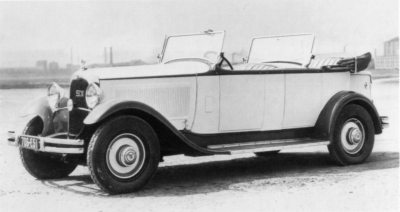 |
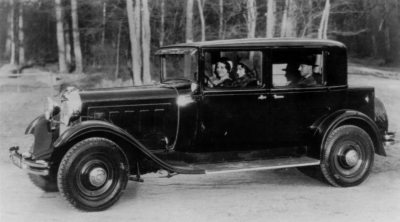 |
|
The 22CV and
the 15CV
In 1934, with
the launch of the 7CV
Traction, CitroŽn no longer
had an haut de gamme model.
However, it was the intention of the
company to offer an entire range of
cars all based on the Traction and
at the top of the range would be the
V8
22CV. For well documented
reasons, the 22CV was never launched
and the position of haut de
gamme fell to the six cylinder
15
Six. The 15 was so far ahead
of its competition that the company
made very few modifications to it
before it was replaced in 1956 by
the DS19.
|
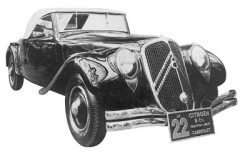 |
|
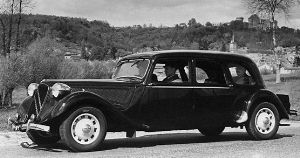 |
In the austere
years after World War Two, the
French luxury car makers disappeared
Ė with the exception of Panhard
who were reduced to making
economical, small cars.
Thus there was
little competition for the 15CV Ė
its Renault,
Peugeot
and Ford
peers were smaller and did not offer
the same levels of comfort or road
behaviour, even if they were more
"modern" in their styling.
|
|
The
DS
The DS offered the kind of
hedonistic comfort that
few other manufacturers
could approach. Not only
did it offer unrivalled
sybaritic luxury but it
managed to do so in a
package that was both
stunningly beautiful and
technologically advanced.
If it suffered major
problems in its early
years, this did not damage
its reputation too
severely - if anything it
added to the mystique. And
the clientele in those
days was less
sophisticated as far as
expectations regarding
reliability are concerned.
|
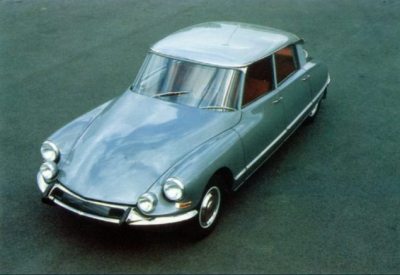 |
|
|
As if the standard DS were not
luxurious enough, three new models
were launched. The Prestige offered
limousine style accommodation in the
rear although the chauffeur,
thankfully separated by a glass
screen from the bloated plutocrats
in the rear, endured IDesque
seatingÖ And then there was the
Pallas for the person who did not
want to give up the driving seat to
a hired hand but still demanded the
luxury of the Prestige. But the haut
de gamme undoubtedly was the Dťcapotable built
by Henri Chapron. Those with more
money than taste could flaunt their
extravagance with one of the bespoke
Chapron creations.
|
|
For a few short
years, Facel
Metallon hand built cars in
the pre War Gran Turismo
fashion but sales of these were
minuscule in comparison to those of
CitroŽn and when the company
disappeared in the mid sixties,
CitroŽn was free to besport itself
without any domestic competition.
The foreign competition ? Mercedes,
Jaguar, Rover, etc. suffered from
high prices as a result of import
taxes and the DS reigned supreme. In
the France of the early sixties, if
you wanted a top of the range luxury
car at a sensible price, the choice
was between a DS, a DS Prestige or a
Chapron DS of one type or another.
If the DS suffered from shortcomings
in the engine department, this was
more than made up by its strengths
in other areas. Over the years, the
DS was refined and improved. More
powerful engines made up the
shortfall in straight-line
performance and a couple of
restyling exercises ensured that it
still looked contemporary.
|
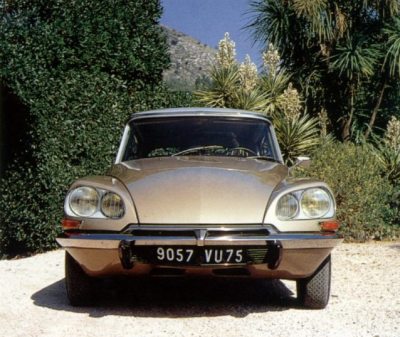 |
|
The SM
The SM
was intended to be positioned above
the DS in the model hierarchy and,
had events not conspired against it,
might very well, in four-door guise,
have supplanted the DS. The SM was
designed to accommodate the four
cylinder powerplant from the DS as
well as the Maserati V6. Sadly,
escalating oil prices coupled with
the widespread imposition of speed
limits and the company's parlous
financial state killed the SM and
the DS laboured on until 1975.
|
|
The CX
At launch, most
D owners viewed the CX
as a retrograde step. Available only
with the DS20 engine, with a manual
4 speed transmission, with reduced
interior room and a fairly basic
trim level, without the steerable
lights of the D, the only obvious
advance was the fitting of DIRAVI
steering on some models.
Had the company
had more resources, the CX range
would have included long wheelbase
variants (subsequently introduced
with the Prestige and Limousine), a
Trirotor Wankel
and a V6 Maserati.
The ultimate
luxury vehicle would have been the
Maserati Quattroporte (below) -
equipped with hydropneumatic
suspension, fully powered brakes and
DIRAVI, this car was pure CitroŽn
apart from the engine and styling.
|
 |
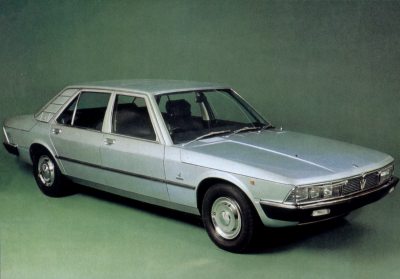 |
With the gradual
fall of fiscal barriers within the
EEC, cars began to sell outside
their country of origin and the CX
faced competition in all its
markets, including France.
The CX was
rapidly developed to face up to the
likes of Mercedes, BMW, Jaguar,
Rover, Ford, BMC, Vauxhall and Opel.
Bigger engines, CMatic semi-
automatic transmission (and later
fully automatic transmission),
Pallas and Prestige trim all
followed in fairly short order and
helped maintain CitroŽnís reputation
as the "anti-Mercedes" but the
Germans were fighting back.
|
|
By the early
eighties, the CX was beginning to
look somewhat dated; the science of
aerodynamics had moved on (the Audi
100 in particular showing the way
with a CD of 0,30 compared with the
0,36 of the CX) and competitors were
offering cars that did most of what
the CX did without the attendant
complications (be they real or
imaginary). Furthermore, the Germans
were ahead of CitroŽn in the field
of safety Ė ABS was introduced by
Mercedes in 1979 and by Ford in 1985
as a standard fitting in the
Scorpio. It was only following
widespread criticism of the
inadequate brakes of the CX GTi
Turbo that CitroŽn offered ABS as a
costly option. And where the CX
Automatique had a three speed box,
the competition offered four speeds.
From being at the forefront of
technical innovation and active and
passive safety, CitroŽn was obliged
to play second fiddle to the
Germans.
PSA had decided
to concentrate its resources on the
new, mainstream car that would make
or break CitroŽn Ė the BX.
Where the BX employed the very
latest, lightweight TU range of
engines, the CX laboured on with the
Sainturat-based engines from the D
or the harsh and unrefined PRV
engine found in the Reflex and
Athena. The diesel engines used in
the CX were basically dieselised
versions of the D lump and were less
refined than the XUD engines fitted
to the BX. Had the money been
available, the CX restyle would have
been much more than the fitting of
new bumpers and interior Ė the
underpan would have been cleaned up,
the roof gutters would have
disappeared, a flush fitting screen
would have been fitted, the roof
line would have been raised to
provide improved rear headroom and a
hatchback would have been fitted.
Extensive use of plastics per the BX
would have helped reduce weight but
PSA said no.
The CX was under
threat, not just from the Germans
but also from the Renault 25 and its
stablemates, the Peugeot 604 and top
of the range BXs.
Not the CX
replacement
But let us
backtrack to 1980. Some five years
after Robert
Opron had left CitroŽn, the
Bureau d'Etudes, under the direction
of Jean Giret, turned from the soon
to be launched BX and concentrated
its energies on working on a
replacement for the CX. This task
was undertaken without the knowledge
or approval of Xavier Karcher and
therefore without any formal design
brief although those in the know
referred to it as Projet
E. The basis on which Giret's
team operated was a re-dimensioned
CX and the car was fitted with a two
piece tailgate allowing a classic
boot or hatchback configuration as
desired. Frontal treatment was not
dissimilar to that of the BX.
Peugeot had made it clear to CitroŽn
that the CX was to be the last
"quirky" CitroŽn. When Art Blakeslee
discovered this model, he ordered it
to be destroyed - and PSA then
imposed its personnel in the Bureau
at Vťlizy. This meant that any
successor to the CX was going to be
a far more conventional beast and
would make extensive use of
components shared with other
vehicles in PSAís range.
The DX?
In late 1984,
PSA's Management Board asked three
styling centres to submit their
proposals for the CX replacement -
two of the centres were in-house PSA
(Vťlizy and CarriŤres-sous-Poissy)
and the third was Bertone. Marcello
Gandini, designer of the BX while at
Bertone also submitted a pair of
models. The design of Projet
V even at this early stage
required a floorpan that would be
shared with Peugeotís new flagship
and with the Saab 9000. The decision
was taken to employ the pseudo
MacPherson strut front suspension of
the BX and the XU range of engines.
For the first time since the demise
of the SM, a V6 would also be
offered.
Eventually,
Bertoneís design was accepted but
the production version lost the
semi-enclosed rear wheels and smooth
flanks that were part of the
original proposal. Also rejected
were head-up instrument displays and
a six headlamp set up.
In 1998, CitroŽn
showed the Activa
prototype at the Paris Salon.
Activa was fitted with active
suspension and four wheel
steer and it was thought inevitable
that the DX (as the pundits had
named the CX replacement) would
feature this technology. In the
event, a simplified version of
Activaís suspension was fitted and
passive rear steer, originally
introduced on the ZX was not fitted
until the mid 90s.
Bienvenue ŗ
la XM
On 23rd
May 1989, the new car went on sale.
Christened XM in order to pay homage
to the SM which was the last six
cylinder CitroŽn, it also featured a
kicked up waist line that was
reminiscent of the SM. Originally
available with a choice of a
carburettor XU engine bored out to 2
litres, a fuel injected version of
the same or a V6, the considerable
extra weight of the XM compared with
the BX endowed the 2 litre versions
with pedestrian performance and even
the V6 was slower than the BX 16
Soupapes. In July 1990, a 170
bhp 24 valve V6 was offered.
Virtually all the 176 24 valve cars
developed problems with oil flow
which led to premature camshaft
failure. CitroŽn must have been
aware that this engine was stretched
beyond its limits but this did not
dissuade them from manufacturing
such a severely flawed car. Then in
1993, a turbocharged 2 litre XU
engine was provided which finally
overcame the performance deficit of
earlier 2 litre models.
The diesel
versions similarly suffered from
lack of performance Ė the XUD was
extended to 2,1 litres and offered
110 bhp compared with the 120 bhp of
the CX 25 Turbo D which was a
lighter vehicle than the XM.
Contrast this however with the 143
bhp of the Mercedes 300D. The
success of the BMW 325TDs led PSA to
drop the 4 cylinder 2,5 litre engine
from the C25 van into the XM in
1996. This unit was, at 130 bhp,
powerful but it could also be
thirsty. Having only four cylinders
as opposed to the six cylinder units
that powered the Germans which were
sold at similar prices and lacking
the image of either BMW or Mercedes,
its appeal was limited to a small
circle of CitroŽn enthusiasts who,
in Britain at least, mainly
purchased second-hand vehicles since
the majority of them were
pre-registered by CitroŽn dealers.
Following the
restyle of 1995 and the fitting of
Hydractive 2 which had been
pioneered in the Xantia,
the XM was not really developed any
further. Activa suspension was not
fitted to this haut de gamme model
but to the mainstream Xantia. The
same held true for the new V6
jointly developed by PSA and Renault
which first saw the light of day in
1996 in the Xantia and a year later
in the XM and also for the
auto-adaptive gearbox. The headlamps
which had been a source of much
criticism were revamped in 1996 but
right hand drive cars continued to
be fitted with the original,
inadequate units Ė presumably the
sales figures did not justify the
development of RHD versions. Similar
lamps were fitted to early versions
of the Xantia but sales were
sufficiently healthy here in Britain
to justify developing replacements.
Other mainstream
manufacturers had abandoned the
large car field to the Germans Ė
Fiat threw in the sponge in 1995 and
Ford did likewise in 1997. Apart
from the Germans, the only other
players are Saab, Volvo and GM with
only GM being a volume manufacturer.
In 1989, 46,282
XMs were sold worldwide. In 1990, a
total of 96,196 were sold and
thereafter, numbers declined rapidly
- 49,119 in 1991, 43,487 in 1992,
20,977 in 1993, 20,591 in 1994,
17,799 in 1995, 12,500 in 1996,
9,594 in 1997, 7,500 in 1998 and
only a couple of thousand in 1999.
More than 45% of total XM production
occurred in the first two years of
an eleven-year run. From 1996, in
its home market of France, the XM
was outsold three to one by each of
its German competitors. Production
ended without any sort of fanfare in
June 2000.
|
|
Year
|
Worldwide
|
UK
|
UK
Sales as a percentage
of world sales
|
|
|
|
|
|
|
|
|
|
|
|
|
|
|
|
|
|
|
|
|
|
|
|
|
|
|
|
|
|
|
|
|
|
|
|
|
|
|
|
|
|
|
|
|
|
|
|
|
|
|
|
|
|
|
|
|
|
|
|
2,49%
|
|

|
|
|
|
|
|
Approximately
ten per cent of all XM production
went to the Netherlands where the
car continues to be very popular
with customers and where values hold
up well. Contrary
to the position in Britain,
most specialist CitroŽn dealers
would be happy to have ten low
mileage, late model XMs sitting on
their forecourts since they have
waiting lists. Many former DS and CX
specialists are now turning to the
XM as their clients have learned to
recognise its very real qualities.
In the French
ContrŰle Technique (MOT) statistics,
the XM came out as the third most
reliable luxury car Ė after the
Mercedes 190 and BMW 5 series. In
the 1998 EuroNCAP safety tests, the
XM was reckoned to be one of the
safest cars in its class Ė not bad
for such an old design.
At launch, PSA
said that 4 x 4 versions of the XM
would follow, together with a classic three
box design intended primarily for
North America.
The XM fell
between two stools Ė it was not
different enough to attract the
hardened CitroŽn enthusiast but was
too different to appeal to
mainstream purchasers. In efforts to
attract mainstream purchasers, the
feel of the brake pedal was made
more conventional thanks to the
insertion of a deformable tube in
the brake valve to make the pedal
feel spongey. DIRAVI was only fitted
to left hand drive V6 models and was
quietly dropped in 1997. The DIRAVI
equipped cars actually had lower
geared steering than the lesser XMs.
The non-turbocharged XM 2 litre was
slower and substantially thirstier
than the BX19TRi and furthermore,
thanks to its Hydractive suspension
did not ride as well.
In some
respects, the XM continued in the
traditional CitroŽn mould Ė it was
released prematurely Ė by at least
eighteen months Ė and suffered from
considerable teething problems which
gave it a reputation from which it
never recovered. The use of totally
inadequate wiring and connectors was
a recipe for disaster and was
undoubtedly brought about by the PSA
bean countersí desires to reduce
costs wherever possible. Quality
control was not all that it might be
Ė many cars suffered from water
leaks and an appetite for front
tyres and brakes did not help
either.
And here in
Britain, the majority of dealers
hated it. They hated it because it
was a slow seller and because of its
reputation for unreliability. The
result was £10k depreciation in the
first year. And for the hapless
owner of one of these cars, there
was the hostility and ignorance of
the dealer network to add to your
woes. To an extent, the hostility
was understandable Ė why tie up
capital in a vehicle that might sit
in your showroom for six months when
you could shift a dozen Xantias in
the same period? The ignorance is a
direct result of the hostility Ė few
dealers ever got to work on an XM so
it was terra incognita to
them. Diagnosing intermittent
suspension faults cost the dealer
man-hours that could not easily be
passed on to the customer.
And then there
is the appearance - a car that looks
like a hatchback in a market that
eschews them as utilitarian.
Unusually styled cars do not
normally sell well in this area of
the marketplace. Nor do front wheel
drive cars.
Yes, the XM was
undoubtedly a failure in commercial
terms and yet it offers all of the
traditional big CitroŽn strengths
and virtues; the ability to make
light work of long journeys in
adverse conditions, unique styling,
excellent aerodynamic performance,
good economy (V6 aside), superb
comfort and luxury; the list goes
on. It offers a unique driving
experience and in true CitroŽn
style, looks like nothing else on
the road.
When it was
launched, I observed that it looked
as if it had been designed by a
committee that had never met.
Familiarity has led me to modify my
views Ė I think it is a great design
which is let down by detailing. The
concave flanks do little for the
aesthetics and the leading edge of
the bonnet should be continued to
the line above the headlamps. There
are too many panes of glass in the
much-vaunted "band of light" while
the front quarter lights are so
designed that when it is raining,
the exterior mirrors are worse than
useless thanks to the water running
across these panes. I like the
exterior door handle design but some
people have likened these to RSJs.
It is a pity that the rear wheels
are fully exposed. The design has
not dated because it is essentially
right Ė just like the DS and the CX.
I suspect that C5
will look old-fashioned in 2012.
CAR magazineís
acerbic comment was "It will be a
great car when it is finished".
Unfortunately, it was both never
finished and is now finished. It was
never finished since development
ceased. It is finished because
production has ceased.
The future
The XM came to
the end of its life without any
immediate successor. For the last
half of 2000, the haut de gamme
was the V6 Xantia. The C5
replaces the Xantia,
not the XM (although it does
encroach on the XM's territory). C6 will
appear, eventually, but for at least
18 months the flagship will be the
V6 C5 Ė just a large-engined version
of a mainstream Mondeo competitor.
C6 is so different looking from its
current competitors (with the
exception of the new Renault) that
it too may suffer from the
conservatism of buyers. On the other
hand, it may be that the market is
changing; people may be becoming
bored with driving ubiquitous BMWs
and Mercedes. And all this
presupposes that C6 will be reliable
from day one, that it will offer a
unique driving experience. Certainly
Audi has demonstrated that cutting
edge technology can be a powerful
force in attracting customers,
indeed Audi seems to have wrested
the technocrown from CitroŽn Ė it is
time to snatch it back.
Working on the
premise that one should learn from
oneís mistakes, I gain the
impression that Peugeot-CitroŽnís
attitude is "We can repeat them
without any difficulty" since once
again, the marque will have two
flagships competing with one
another.
My thanks are
due to Paul Johnson, Wouter Jansen
of CITROExpert
and CitroŽn
UK Ltd. for their invaluable
input into this article. The idea
for this article came about as a
result of discussions with Nigel
Wild of the CitroŽn
Car Club who cautioned me
against suggesting that the XM is a
"real CitroŽn" since, like its
forebears, it was launched while
still in prototype form. As you will
have read, I ignored his warnings
since I believe the point is valid.
Furthermore, the word is out that a
number of C5s issued to dealers have
suffered from teething problems Ė
failed power steering Ė over-light
power steering Ė braking problems Ė
rear suspension sub frame problems -
problems with some of the
electronics - lack of power in the
2,2HDi. If this is true, then C5
continues in the grande
tradition. I rest my case,
Nigel.
©
2001 Julian Marsh
|
|
|
|